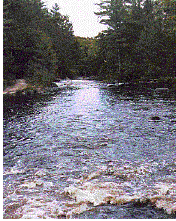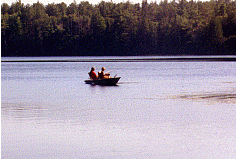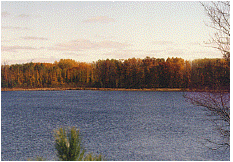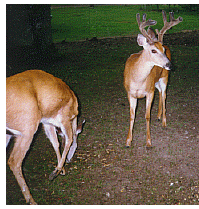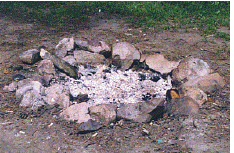The Nicolet National Forest is located in northern Wisconsin, 20 miles from Iron Mountain, Michigan in the Upper Peninsula. Take Highway US 2/141 northwest from Iron Mountain to Florence, WI. Then take Highway 70 to the Nicolet. State Highway 70 goes through the heart of the Nicolet National Forest. Forest roads go off to the right and left leading you to lakes, streams, campgrounds, and all the other attractions of the Nicolet. (map). Be sure to stop at the Wild Rivers Interpretive Center at the junction of Highways US-2 & Wisconsin State Hightway 70 on the west side of Florence for your maps and information. Enjoy your wilderness experience, then return to comfortable lodging, fine dining and interesting things to do in Iron Mountain, MI. If you want to obtain maps and an information packet about the Nicolet, stop at the Florence Natural Resource and Wild Rivers Interpretive Center at the intersection of Highways 70/101 and US 2 just west of Florence, WI. Their phone number is 715-528-5377. The Nicolet National Forest offers you a wealth of opportunities to enjoy the outdoors. Towering pine and hardwood forests are interspersed with hundreds of crystal clear lakes and streams. Within a day's drive of the Chicago, Milwaukee, St. Paul, and Minneapolis metropolitan areas, the Nicolet is a place where you can truly "get away from it all" in the scenic beauty of the northwoods. Four seasons of recreation await you... from spring fishing or canoeing to summer camping, hiking, mountain or horse back riding. Come in autumn for hunting or to see our famous fall color. For your driving pleasure there are 3,600 miles of back roads. Please drive slowly. Snow season gears up with cross-country skiing and snowmobiling. Or come anytime to get close to nature in a tranquil and secluded spot. Opportunities for exhilarating views, relaxation, and quiet nature study abound. Experience all the beauty and recreational opportunities of one of our National Forests.
Native Indian tribes were the first to explore and eventually settle this region followed by voyageurs, missionaries, loggers, farmers, and miners. Much of this natural beauty and colorful human history can be enjoyed today in the Nicolet. In 1634, Jean Nicolet, a French explorer, discovered what the native Indian tribes already knew to be a beautiful resource rich land. Little did Nicolet know that 300 years later a National Forest would be named in his honor. The Nicolet was established in 1933 and now comprises over 661,000 acres in northeastern Wisconsin. The Nicolet National Forest naturally draws people interested in swimming, boating, canoeing, rafting, and fishing. Come to hike, ski, snowmobile, hunt, fish, swim or view wildlife. Anglers can expect to find a large variety of fish including trout, pike, bass, muskellunge, walleye, and panfish. Canoeing enthusiasts may wish to try the Brule, Pine, Popple, Peshtigo, Rat, Oconto, and Wolf Rivers, all of which are easily accessible. Swimming is offered at most of the campground lakes and at several developed beach and picnic areas. The Nicolet is 62 miles long, north to south, and 36 1/2 miles wide. There are 1,170 lakes and over 400 spring ponds. The lakes have 34,000 surface acres of water and 500 miles of shoreline. Fresh water streams have a total length of 400 miles, including 580 miles of trout streams. There are 40 miles of white water canoeing rivers, of which 40 miles are state protected "wild rivers." Sixty-eight species of fish live in these waters. The Nicolet National Forest offers "developed" campgrounds that provide campsites with a fire ring, picnic table, tent or trailer pad, and parking. Drinking water, toilets, and trash pickup are also provided. Electrical hook-up facilities and showers are not provided. All campgrounds have some sites that can accommodate RVs up to about 30 feet long.The main camping season is Memorial Day through Labor Day. If you don't want to camp, at least have a picnic at one of the nearby Nicolet campgrounds or picnic areas.
For more remote experiences, the Nicolet has Whisker Lake, over 7,500 acres of Congressionally designated wilderness. For the more adventuresome visitor, this designated wilderness in the Nicolet provides opportunities for a primitive, non-motorized experience. These areas are rarely used and provide the ultimate opportunity to "get away from it all". Visitors who are looking for peace and solitude can find solace in the wilderness areas. Here are outstanding opportunities for hiking, hunting, or camping in a remote setting. Parking is available at the entrance to the Whisker Lakes Wilderness area. The deer population in the Nicolet is conservatively estimated at 24,000 or 24 per square mile. About 250 black bears live in the forest, about one per four square miles. There are a few wolves. Wildlife watchers, as well as hunters, enjoy the Forest's abundant wildlife, including bald eagles and loons, deer, bear, grouse, waterfowl, and many species of songbirds and small mammals, including the American Sables and the Fisher. Birdwatchers have seen 320 species of birds in the Nicolet. It has about 36 pairs of nesting ospreys and about 30 pairs of nesting bald eagles. Plant species total 961. Loons, bald eagles, great blue herons, ducks, geese, and songbirds are common sightings in the Forest. There's also a good chance you'll see white-tailed deer on any of the trails you visit. Over 800 miles of trails are open to the public for activities such as hiking, cross country skiing, horseback riding, snowmobiling, and even dog sledding. Snowmobile trails cover 450 miles. Groomed cross county ski trails are 120 miles long. Hiking trails total 65 miles.
Camping - Pitch a tent or park a camper for a modest fee in one of the developed campgrounds in the Nicolet. All of the Nicolet campgrounds are located on lakes or streams and have drinking water, vault toilets, picnic tables, and grills or fire rings. The Nicolet has 23 developed camping sites for 460 family camping units, plus 4 units developed for larger camping groups, and 3 sites with developed walk-in camping areas, each with 5 campsites. There are 6 free day use picnic areas, or picnic at one of the campgrounds. Four of the favorite camping/picnicking spots are Chipmunk Rapids, Perch Lake, Lost Lake, and Morgan Lake. The Forest also offers numerous opportunities for camping outside developed campgrounds in more primitive and remote settings. The National Forest Service is continually working to improve their campground qualities and services, including providing more barrier-free opportunities for people with disabilities. Please call the office for current facility information. In season there are tons of fresh raspberries, blackberries and blueberries in the Nicolet -- all free for the picking. Just grab a bucket or eat as you pick them. Hiking Trails - The Nicolet has three National Recreation Trails and numerous other trails that offer hiking in beautiful forests and along lakeshores. Some are accessible for people with disabilities, while others are more rugged with steeper terrain. Lengths range from 1/4 mile to over 15 miles. Some individual trails connect for longer treks if you desire. Many trails intersect with Forest campgrounds, like the Lauterman Trail which also offers walk-in camping. Hiking trails are available in the Forest's wildernesses. These trails are shown on the Forest Wilderness Map available at all Nicolet National Forest offices. The Nicolet has ten interpretive trail opportunities from short nature trail hikes to longer auto tours in areas of scenic, natural, or historic interest. Signs and brochures explain trail features. One of these favorite trails for hiking is the Assessor's Trail at Lost Lake. Guided nature trail hikes are also offered in the summer season. Mountain Biking Trails - The Nicolet doesn't have any mountains to climb, but it does have many miles of trails and back country roads where you can enjoy your mountain bike. Some trails also double as ski trails in the winter They accommodate a range of skill levels, passing through a variety of terrain and landscapes.
Cross-Country Ski Trails - The exhilarating swoosh of skis as you speed down the hill and the breath-taking climb up the other side are all part of the cross-country experience offered by many of the trails on the Nicolet. Variable lengths and slopes are available for all skill levels, and many of the trails are groomed for both ski skating and traditional skiing. A few also offer warming huts or shelters for resting along the way. Lauterman Trail is a favorite for x-country skiers Hunter Walking Trails - Hunter walking trails are woods roads that are located in high quality ruffed grouse and woodcock habitat areas. To many people, the trails conjure visions of a bright blue, cool autumn day combined with the sounds of colorful fallen leaves crunching underfoot. There are 120 miles of mowed hunter-walking trails and numerous wildlife management areas. For information about hunter walking trails, please contact the District Ranger Station in the area you are interested in hunting. Snowmobile Trails - A vast network of nearly 800 miles of signed, groomed trails, and hundreds of miles of unplowed National Forest roads are available. Trails are maintained by local snowmobile clubs in cooperation with counties and the Wisconsin Department of Natural Resources. Snowmobile use is permitted on designated trails and unplowed National Forest roads when snow cover is at least four inches. You may contact one of our Forest offices for more information. Equestrian Trails - Riders can take in the scenery from horseback by riding any of the numerous old roads in the Forest. A few trails are also available for equestrians. All Terrain Vehicle and Motorcycle Trails - The Nicolet does not at this time have any trails open to ATV or motorcycle use. Forest Maps - Detailed maps of the Forest (1/2" per mile) and topographic quadrangle maps are available for a fee from any Forest office. Forest Roads are marked with numbers, such as 2178. Look for small brown and white signs identifying these routes throughout the Forest.
What to Expect . . . Weather - You will rarely need air conditioning in the northwoods. Summer nights are usually cool and great for sleeping. Temperatures range from the 60's to 80's (sometimes 90's) in the day and can get down to the 40's at night. So, pack an extra sweatshirt or light jacket just in case. Bugs - Yes, we do have our share of bugs here, too. Early summer through July is the time when mosquitoes are most prevalent. Black flies are around from snow melt until mid-June, and deer flies are out in June and July if the weather is dry and warm. Ticks are out mainly during spring and early summer, and are more common in grassy areas. It helps to wear light colored clothing, check yourself periodically, and use repellent. Deer ticks, which carry Lyme disease, are very small, about the size of a pin head. Lyme disease is not as common as visitors think. Wood ticks are larger and more common, but are gone by mid July, if not before. There are no poisonous snakes, vines or insects in the Nicolet. Passport Program - If you're 62 years or older or have a disability you can qualify for a Golden Age or Golden Access Passport. This entitles you to a 50 percent discount on campsites. Obtain a passport at any National Forest office. User Fees/ Reservations - A campsite fee is charged at each campground. Most campsites are on a first-come, first-served basis. Sites may be reserved at some of the campgrounds for an additional fee. Information concerning fees and the campsite reservation system is available at any Forest office. Fee information is also posted at each campground pay station. The fee is usually $8-$10 per night Occupancy - A maximum of eight persons per site is permitted. Campsites must be occupied the first night, and no equipment may be left unattended for more than 24 hours. Maximum occupancy is 14 days. Vehicles and trailers are to be parked only on the spurs provided. Barrier-Free Access - We are currently in the process of upgrading toilet, picnic, boating, fishing, swimming, and trail facilities to make them more accessible to persons with disabilities. For the latest information, please contact one of the Forest offices. Seeing-eye dogs are welcome throughout the Forest. Pets - To keep pets from disrupting other campers, please keep them on a leash at all times. Pets are not allowed on any beach area for sanitary reasons.
Fireworks - Because of the danger of forest fires, discharging fireworks is not permitted anywhere in the Nicolet National Forest Firewood - Firewood may be provided in some campgrounds. You may also gather dead or down wood where available, or purchase firewood from a local vendor, such as a gas station in Iron Mountain or Spread Eagle WI. Overall the forest provides a tremendous amount of free or inexpensive recreation, as well as essential forest products. For more information about recreational opportunities in the Nicolet National Forest, please contact the following offices:
Recreation in the Upper
Peninsula of MI Northern Wisconsin Lodging Back to Home Page: Exploring the North
Copyright 2002 by Vivian Wood, the webmaster for Exploring the North, Inc. All Rights Reserved. Except as permitted under the Copyright Act of 1976, as amended, this web site may not be reproduced in whole or in part in any manner. Unless authorized by the webmaster of Exploring the North, Inc., reproduction of any picture, web page or pages on this website for placement on the internet is a copyright infringement. All right, title and interest in and to the material on our web pages, the web site, in whole or in part, and in and to this url and the urls contained within, is the property of the webmaster for Exploring the North, Inc. All website design, text, graphics, selection and arrangement thereof are the copyrighted works of Vivian Wood. Web site created on an Apple G-4.
|
|||||||||||

